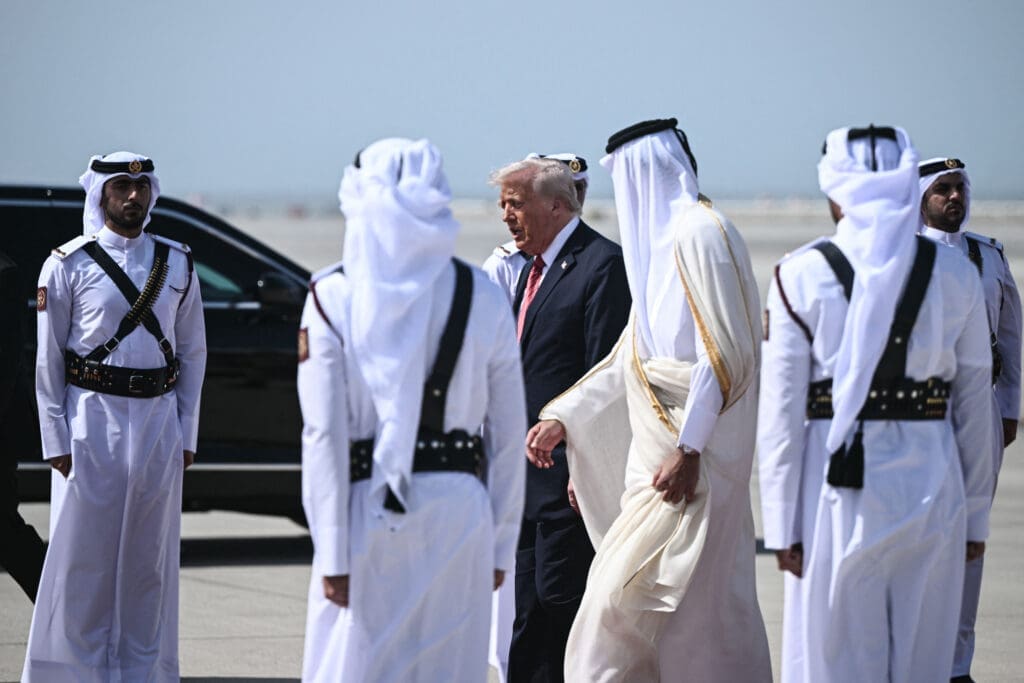Earlier this year, U.S. President Donald Trump returned to the Gulf with a familiar list of themes: deals, defense and data. Over four days, he visited Saudi Arabia, the UAE and Qatar, securing over $2 trillion in investment pledges and announcing sweeping agreements on artificial intelligence, fossil fuel infrastructure and defense. Yet one issue was conspicuously absent from the agenda: cooperation on climate change.
This omission was not accidental. It marked a deliberate pivot away from the climate-focused diplomacy of the Biden administration and toward a transactional model that prioritizes short-term economic and strategic gains, aligning with Trump’s “Energy Dominance” agenda. Yet in a region increasingly prone to severe environmental vulnerabilities, the omission underscores growing misalignment with the Gulf states, which are defining their strategic identities through climate leadership. Trump’s Gulf tour emphasized transactional gains, but left unanswered the question of how this new diplomacy aligns with the region’s long-term sustainability goals.
From Gulf Vulnerability to Leadership
Trump’s anti-climate rhetoric ironically comes at a time when Middle Eastern and, in particular, Gulf countries are asserting themselves as global climate leaders. The UAE hosted the COP28 Climate Summit in 2023, has invested heavily in nuclear energy, green hydrogen and renewables, and became the first MENA country to announce a national target of Net Zero by 2050. The COP28 ended with a call to “transition away from fossil fuels,” which was applauded as an historic milestone in global climate action—while also producing its fair share of criticism for not going far enough.
Saudi Arabia’s Vision 2030 includes sweeping sustainability goals, signaling its intent to lead on climate action both regionally and globally. The kingdom has also committed to achieving net zero emissions by 2060. Qatar has advanced climate finance initiatives and adaptation strategies, particularly in water security and urban resilience and has updated its Nationally Determined Contributions (NDCs) and pledged to reduce CO2 emissions by 25% by 2030. Furthermore, Qatar has endorsed the Global Methane Pledge, an initiative to cut emissions of another powerful greenhouse gas, building on Qatar’s status as a founding member of the Net-Zero Producers Forum. Qatar was also the host of COP18 in 2012, the first UN climate summit to be held in the Gulf, signaling the region’s growing desire to have a hand in shaping international climate diplomacy.
These efforts are not merely reputational, but reflect a strategic recognition that climate resilience is existential. Rising temperatures, water scarcity and extreme weather events threaten infrastructure, food systems and economic stability. Moreover, climate leadership has become a tool of soft power in the region. By hosting COPs, launching green funds and engaging in multilateral climate diplomacy, the Gulf states are reshaping their regional and international leadership roles in the new energy landscape.
Trump’s 2025 Gulf tour was choreographed for maximum optics and political mileage back home. In Riyadh, he was greeted with a lavish royal welcome and reaffirmed his rapport with Crown Prince Mohammed bin Salman. In Abu Dhabi, he toured AI data centers and praised Emirati innovation. In Doha, he celebrated Qatari mediation efforts and announced aviation and defense deals. But across all three stops, climate action was absent from public statements and bilateral agreements.
Instead, the focus was on the economic spectacle. Saudi Arabia pledged $600 billion in U.S. investments, including on defense, energy and critical minerals. The UAE committed $1.4 trillion toward AI infrastructure and tech partnerships. Qatar announced a record-setting $96-billion Boeing order as part of an aviation deal, along with defense deals. These deals were framed as breakthroughs in economic statecraft, positioning the Gulf as a central pillar of Trump’s second-term foreign policy.
Climate cooperation was predictably absent, an exclusion that highlights a widening gap between U.S. diplomacy and Gulf priorities. This was in contrast to former U.S. President Joe Biden’s visit to COP27 in Egypt and then Vice President Kamala Harris representing Washington at COP28, which reflected a commitment to decarbonization, climate finance and multilateral engagement. Those visits underscored the importance of aligning with global climate frameworks and Gulf aspirations for climate action. Trump’s tour, by comparison, marked a clear pivot towards investment-led partnership, defense, fossil fuels and technology, sidestepping traditional alliances and the climate commitments that Gulf states increasingly view as central to their visions and strategic future.
Climate Inaction vs. Strategic Alignment
In January 2025, Trump withdrew the U.S. from the Paris Climate Agreement for a second time, abruptly ending its participation in global climate diplomacy. This came after the Biden administration had rejoined the accord in 2021 (following Trump’s pullout in his first term) and passed landmark legislation including the Inflation Reduction Act and Infrastructure Investment and Jobs Act, which had positioned the U.S. as a global climate leader.
For the Gulf states, the U.S. retreat from climate collaboration signals a misalignment with their own evolving priorities. These states are increasingly engaging with Europe, China and multilateral institutions on climate finance, food security and green technology. The EU-GCC Clean Energy Partnership and China’s green investments within its Belt and Road project offer alternatives to U.S. engagement.
The absence of climate dialogue also undermines trust. Gulf partners expect consistency and a long-term vision. Diplomacy focused solely on defense and fossil fuels may deliver short-term gains, but lacks the longer view the Gulf states now demand as they redefine themselves through sustainability and climate action. Trump’s tour prioritized economic deals, yet left unanswered how these investments align with regional climate goals. Without climate safeguards, these investments risk exacerbating environmental stress and undermining the Gulf’s transition towards resilience and innovation.
Even where the two sides were aligned, such as on AI and energy infrastructure, the climate question lurked in the background. The UAE’s announcement that it would build the largest AI data cluster outside the U.S. in partnership with U.S. firm OpenAI was framed as a strategic leap. Yet without climate integration, such energy-hungry projects risk deepening ecological vulnerabilities, from water-intensive data centers to carbon-heavy energy grids.
Energy deals focused on fossil fuel expansion also contradict the region’s decarbonization goals. Although Gulf states continue to monetize hydrocarbons, they are also investing heavily in carbon capture, renewables and green technologies. A U.S. approach that ignores this duality risks misalignment with regional ambitions.
Furthermore, the climate gap in U.S. diplomacy may hinder innovation. Gulf states are exploring climate-tech solutions, from desert agriculture for food security to solar-powered water desalination. By excluding the climate from bilateral cooperation, the U.S. could miss opportunities to co-develop technologies that address shared challenges.
The Gulf is no longer a passive recipient of global climate agendas: it seeks leadership at home and aboard. From hosting COP summits to launching regional and global green initiatives, Gulf states are embedding environmental governance into their strategic identities. Their climate ambitions are not merely symbolic; they reflect a calculated response to existential risks and a desire to lead the energy transition.
The absence of climate cooperation in U.S. diplomacy introduces a growing misalignment. Yet Gulf countries are forging ahead with energy transitions, climate tech innovation and multilateral climate finance with countries more aligned with their vision. The lack of climate engagement from Washington risks not only sidelining the U.S., but also complicating Gulf states’ efforts to maintain momentum and coherence in their sustainability agendas. These governments may respond by recalibrating their partnerships, prioritizing those that reinforce their climate goals and strategic autonomy.
In a world increasingly defined by climate impacts, risk and resilience, diplomacy that ignores the climate is not just incomplete—it is obsolete.


